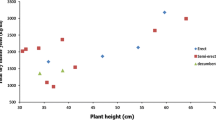Abstract
Sesame, Sesamum indicum L. is used worldwide for cooking oil and food. The United States Department of Agriculture, Agricultural Research Service, Plant Genetic Resources Conservation Unit (USDA, ARS, PGRCU) conserves 1,226 accessions originating from Europe, Africa, Asia, North America, and South America. Sesame accessions were directly seeded to the field in Griffin, GA between 15 May and 01 June 2003–2007. At 50% maturity, 192 accessions were characterized for morphological, phenological, and reproductive traits during the regeneration cycles. High quality plants regenerated from all accessions produced 131 to more than 80,000 seeds per accession. Sesame can be successfully grown and regenerated in Griffin, GA. Coefficients of variation and principal component analysis revealed considerable variability among accessions for phenological, morphological and reproductive traits. Assuming appropriate levels of heritability, sufficient variation among sesame accessions exists for days to maturity, plant height, and reproductive traits among these sesame accessions to warrant breeding programs for new sesame cultivar development.
Similar content being viewed by others
References
Ashri A (1998) Sesame breeding. Plant Breed Rev 16:179–228
Ashri A (2007) Sesame (Sesamum indicum L.). In: Singh RJ (ed) Genetic resources chromosome engineering, and crop improvement, oilseed crops. CRC Press, Taylor and Francis Group, Boca Raton, US, pp 231–289
Bedigian D (2004) History and lore of sesame in southwest Asia. Econ Bot 58:329–353
Hou RC, Huang HM, Tzen JT, Jeng KC (2003) Protective effects of sesamin and sesamolin on hypoxic neuronal and PC12 cells. J Neurosci Res 74:123–133
IPGRI, NBPGR (2004) Descriptors for sesame (Sesamum spp.). IPGRI, Rome; NBPGR, New Delhi
Kobayashi T (1986) Goma no kita michi. [The path of sesame]. Iwanami Shoten, Japan
Langham DR, Wiemers T (2001) Progress in mechanizing sesame in the US through breeding. In: Janick J, Whipkey A (eds) Trends in new crops and new uses. ASHS Press, Alexandria, VA, pp 157–173
Miyahara Y, Komiya T, Katsuzaki H, Imai K, Nakagawa M, Ishi Y, Hibasami H (2000) Sesamin and episesamin induce apoptosis in human lymphoid leukemia Molt 4B cells. Int J Mol Med 6:43–46
Namiki M (1995) The chemistry and physiological functions of sesame. Food Rev Int 11:281–329
National Plant Germplasm System (2008) Germplasm Resources Information Network (GRIN). Database Management Unit (DBMU), National Plant Germplasm System. United States Department of Agriculture, Beltsville, MD
Noguchi T, Ikeda K, Sasaki Y, Yamamoto J, Yamori Y (2004) Effects of vitamin E and sesamin on hypertension and cerebral thrombogenesis in stroke-prone spontaneously hypertensive rats. Clin Exp Pharmacol Physiol 2:S24–S26
Were BA, Lee M, Stymne S (2001) Variation in seed oil content and fatty acid composition of Sesamum indicum L., and its wild relatives in Kenya. Sveriges Utsadesforenings Tidskrift 111:178–193
Williamson KS, Morris JB, Pye QN, Chandrashekhar DK, Hensley K (2007) A survey of sesamin and composition of tocopherol variability from seeds of eleven diverse sesame (Sesamum indicum L.) genotypes using HPLC-PAD-ECD. Phytochem Anal 19:311–322
Yermanos DM (1980) Sesame. In: Fehr WR, Hadley HH (eds) Hybridization of crop plants. American Society of Agronomy and Crop Science Society of America, Madison, WI, pp 549–563
Yermanos DM, Hemstreet S, Saleeb W, Huskar CK (1972) Oil content and composition of the seed in the world collection of sesame introductions. J Am Oil Chem Soc 49:20–23
Author information
Authors and Affiliations
Corresponding author
Rights and permissions
About this article
Cite this article
Morris, J.B. Characterization of sesame (Sesamum indicum L.) germplasm regenerated in Georgia, USA. Genet Resour Crop Evol 56, 925–936 (2009). https://doi.org/10.1007/s10722-009-9411-9
Received:
Accepted:
Published:
Issue Date:
DOI: https://doi.org/10.1007/s10722-009-9411-9




